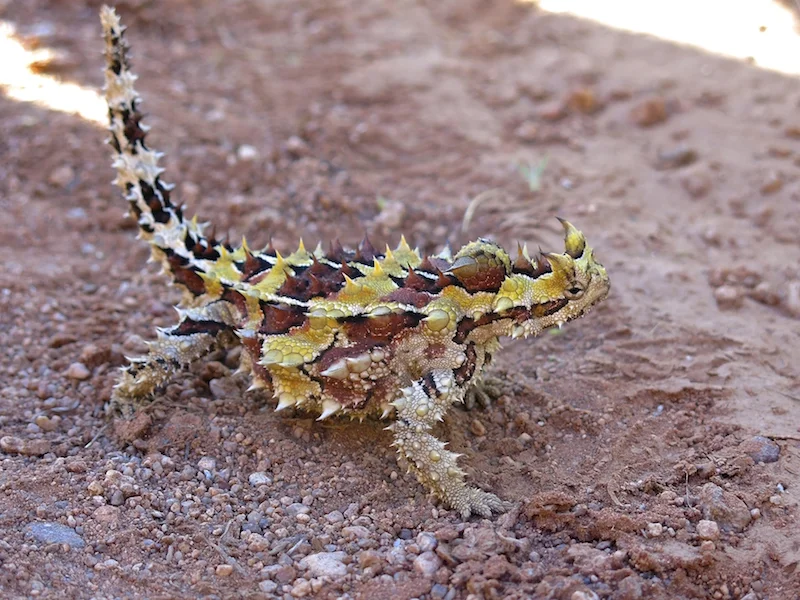The thorny devil looks very fierce.
It is a small lizard that eats only ants.
It lives in the Australian desert.
It has spikes to protect it.
Rain drops run past the spikes and into its mouth.
Thorny devil . Can you see the 'false head' bump on the back of its neck? Getty Images
The fierce-looking thorny devil, also known as moloch, is actually a small slow-moving harmless lizard.
Lizards belong to the group of animals called reptiles.
Habitat and Distribution (where it is found)
The thorny devil is found in the dry scrub and desert of Australia's dry centre.
Appearance and Behaviours
A thorny devil is about 20cm long. Females are larger than males. Thorny devils often curve their tail up in the air. In the hottest part of the day, the thorny devil digs a shallow burrow, often under a shrub, for shade.
Thorny devils often curl their tails in the air. Getty Images
The thorny devil is not aggressive. It has quite a few ways of hiding or defending itself if threatened. Its colours match those of the desert - pale browns and tans when it is warm and darker shades when it is cold, so that it is always well camouflaged.
Its body is entirely covered with cone shaped spikes making it hard to pick up as well as looking fierce. On the back of its neck there is a hump that is called a 'false head'. When threatened, the thorny devil tucks its head between its front legs leaving its false head showing. This confuses predators. If a predator tries to flip it onto its back, the thorny devil uses its spikes and curved tail to anchor itself onto the ground. As well as all that, It can imitate a leaf flicked by a breeze and it can puff itself up to look larger and fiercer.
A thorny devil's predators include birds of prey such as bustards and large members of the lizard family called goannas.
Diet
Getty Images
The thorny devil eats only ants, mainly one particular kind of ant, eating about 1000-3000 ants in a single meal. However, it eats the ants one at a time, flicking its sticky tongue in and out quickly.
It drinks water in a most unusual way. When either rain or dew lands on the thorny devil's back, the water flows along thousands of grooves between the spines that lead to the corners of its mouth so that it can drink.
Life Cycle
The thorny devil is about 20cm in size. Getty Images
After mating in September, female thorny devils lay 3-10 eggs in a burrow about 30cm underground. The eggs hatch after about 3 months.
A thorny devil's life span is about 20 years.
It is always a good idea to use more than one source of information, so here are some others for you to investigate
Read more about the thorny devil here:
https://www.activewild.com/thorny-devil-facts/





